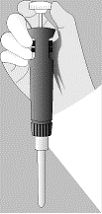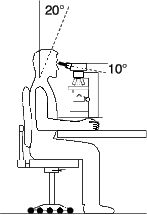| Page 3 |

|
|
1 - Ergonomic
2 - Page 3 3 - Page 4 4 - Page 2 5 - Page 5 6 - Page 6 |

Protective Measures to Help Eliminate or Reduce Ergonomic Stressors During Routine Laboratory Prodecures
A. PIPETTING
 |
- Purchase an electronic operated or a latch-mode pipetter to replace manual plunger-operated pipettes. Both of these units reduce the need for excessive thumb force and repetition. Electronic pipettors are strongly recommended for highly repetitive tasks.
- Use thin-walled pipette tips that are easy to eject.
- Limit periods of continuous pipetting to 20 minutes or less. Vary activities, or take frequent short breaks (e.g., 2 minutes for every 20 minutes of pipetting).
- Rotate pipetting tasks among several people.
- Work with arms close to the body to reduce strain on shoulders.
- Keep head and shoulders in a neutral position (bent forward no more than 30 degrees)
- Use adjustable chairs or ergo-task stools with built-in solid foot rest.
- Don't elevate your arm without support for lengthy periods.
- Use low profile waste receptacles for used tips. These should be no higher than the top of the tubes being filled.
B. MICROSCOPY
- Use a fully adjustable ergo-task chair or stool with built-in solid foot rest.
- Adjust the eyepieces and angle of observation to prevent neck strain.
- Use adjustable microscope stands.
- Use proper sitting posture and positioning.
- Take stretch and rotate tasks.
- Use lifters and angled microscope arm supports to relieve fatigue and strain.
- Ensure that sufficient knee and leg space is available.
- Use television systems to eliminate the use of binocular eyepieces when appropriate.
Workstation Set-up For Microscopy
  |
C. CELL COUNTERS
 |
- Purchase an electronic differential tally counter to replace manual counter. Soft keys permit accurate and fast counting with decreased hand fatigue.
- Reduce the force needed to strike the manual counter.
- Use an edge protector to reduce stress on the forearm and wrist.
- Take frequent short breaks.
- Rotate tasks among several people.
- Use an adjustable chair or ergo-task stool with built-in solid foot rest.
D. LABORATORY HOODS/BIOLOGICAL SAFETY CABINETS (BSCs)
 |
- Position materials in laboratory hoods/BSCs as close as possible to avoid extended reaching. Perform work at least 6" back into the laboratory hood for safety reasons.
- Use a fully adjustable ergo-task chair or stool with built-in solid foot rest.Apply foam padding to the front edge of the hood/BSC (away from the downdraft) to reduce contact forces with the forearm and wrists.
- Use an anti-fatigue mat if you will be standing for long periods of time while working in hoods/BSCs.
- Make sure that lights in hoods/BSCs are working properly. Call appropriate person for replacement of bulbs.
- Use proper sitting posture and positioning.
- Take short breaks to relieve forearm and wrist pressure caused by leaning on front edge of hoods/BSCs.
- Use an ergonomically designed footrest if you will be working for long periods in a BSC.
E. CENTRIFUGE ROTORS
 |
F. LABORATORY WORKBENCHES
- Laboratory workbenches are at fixed heights and have been designed using general guidelines suggested by the National Institute of Occupational Safety and Health (NIOSH). Theses guidelines are as follows:
- Precision Work - Workbench height should be above elbow height.
- Light Work - Workbench height should be just below elbow height.
- Heavy Work - Workbench should be 4-6 inches below elbow height.
- Preventive Measures:
- Use a fully adjustable ergo-task chair or stool with built-in solid footrest.
- Use anti-fatigue mats if you will be standing for long periods of time while working at the laboratory workbench.
- Remove drawers, supplies and other materials underneath workbenches to provide leg room.
- Use an ergonomically designed footrest if your feet do not rest comfortably on the floor.
G. MICRO-MANIPULATION & FINE MOTOR SKILLS
- Use plastic vials with fewer threads to reduce twisting motions during capping and uncapping lids.
- Use small pieces of foam, similar to the type used on pencils and pens to prevent soreness on the fingertips, where fingers and forceps articulate. This will distribute the force out over a greater surface area, thus reducing the compressive forces on the soft tissue.
- Practice using forceps between the first and second digits instead of using the thumb and the first digit. Then try alternating between the two positions to reduce the use of the thumb extensors and flexors. The thumb is used repetitively with almost every job task performed in the laboratory.
- Tilt storage bins toward the worker to reduce wrist flexion while reaching for supplies.
- Take short breaks and do hand, wrist and forearm exercises.
H. OVERHEAD LIFTING
- Use a footstool or stepladder to reach objects that are stored on shelves. Avoid asymmetric lifting (twisting). The object to be lifted should be directly in front of the worker.
- Store materials that are frequently used on shelving units no higher than shoulder height.
- Store materials as close to the employee as possible or permitted. This reduces excessive reaching for objects.
I. VIDEO DISPLAY TERMINALS (VDTs)
 |
The American Academy of Opthalmology describes VDTs as presenting no hazard to vision. VDT exposure does not result in cataracts or any other damage to the eye. According to the National Safety Council, any close work can cause discomfort and stress with time. Occasionally you should:
- stretch
- look away from your work
- get up
- do other tasks to alter work routines throughout the day
VDTs and Radiation
The National Institute for Occupational Safety and Health (NIOSH), the U.S. Army Environmental Hygiene Agency, and others have measured radiation emitted by VDTs. The tests show that levels for all types of radiation are below those allowed in current standards. In fact, some measurements show radiation levels so low that they cannot be distinguished from general environmental radiation (background radiation).
Currently, OSHA has no reliable information that any birth defects has ever resulted from a pregnant woman working at a video display terminal. However, the possible effects of radiation from VDTs on pregnancies continue to concern employees. Therefore, NIOSH and others are currently conducting major studies to thoroughly investigate any potential problems.
| << Previous 1 [2] 3 4 5 6 Next >> |

